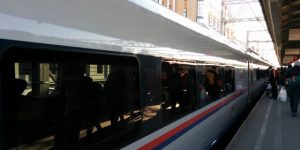Opposite the north gate to the Forbidden City lies Jingshan Park. The park was opened as an imperial garden in 1368, but when the moats and canals around the Forbidden City were excavated the soil was used to build an artificial hill with five peaks. This huge work of manual labour was carried out to improve the feng shui of the imperial city as it is considered favourable to live to the south side of a hill. More practically it’s useful in Beijing as the cold winds blow from Siberia in the north, so Jingshan Hill shelters the residences in the palace below.
Walking round the base of the hills there are a number of gardens and courtyards where people can be seen dancing, singing and playing foot badminton. The gardens here seem to be getting used as allotments by some ofthe older people, so in amongst the flowers and bushes it’s possible to spot the occasional carrot or spinach plant.
On the northern edge of the partk the colourful Hall of Imperial Longevity has been turned into the Beijing’s Childrens Palace, where young people can continue to practice the traditional arts such as dancing and calligraphy. In the open spaces the traditional kuaibanr tellers continue a popular form of storytelling that sounds like a fast rap, to the accompaniment of a beat made by bamboo boards:
The park has historical significance as well – on the east side is a Scholar tree where the last Ming emperor committed suicide in 1644. He was facing capture and execution after the rebel forces of Li Zi Cheng captured the inner city of Peking. Gathering the whole family and household for a feast, he killed them all with a sword then fled to the park where he hung himself aged just 16.
The tallest peak is Jingshan Hill and at 45.7m it was the highest point in Beijing until the recent construction of the skyscrapers in the distant CBD. Each of the five peaks is topped by an elaborate pavilion that all used to house a bronze Buddha, symbolizing the five tastes: acid, spicy, bitter, sweet and salty. Unfortunately four of these were looted, and one destroyed, by the Allied Expeditionary Force during the Boxer Rebellion in 1900.
Atop the middle peak is the Pavilion of Everlasting Spring (Wanchun-ting). From here it’s possible to see across the golden roofs of the Forbidden City as far as the (appallingly out of place looking) Peking Opera House to the south. To the west can been seen the lakes of Beihai and Shichahai, as well as the White Dagoba Temple and directly north is the Bell and Drum tower.
It’s a beautiful park and well worth a visit, but bear in mind there’s a lot of walking and climbing involved.








Pingback: Tips for visitors to The Forbidden City in Beijing
Pingback: What to Do in Beijing - Travel Tips for Beijing, China